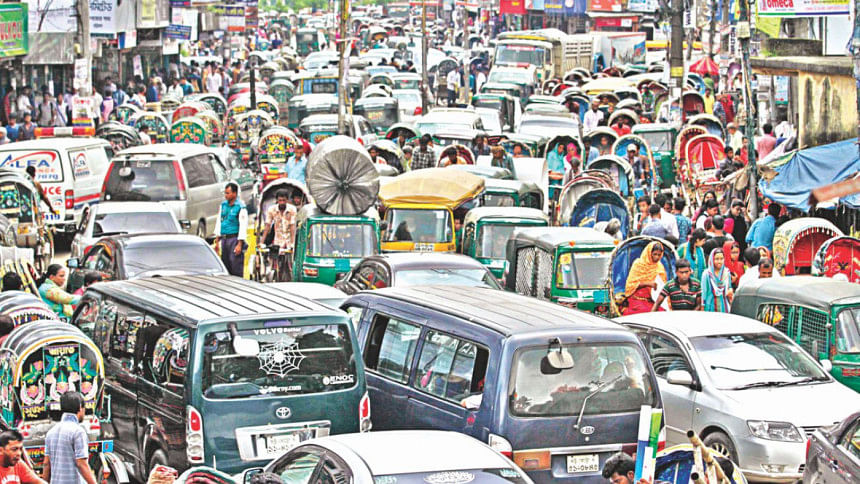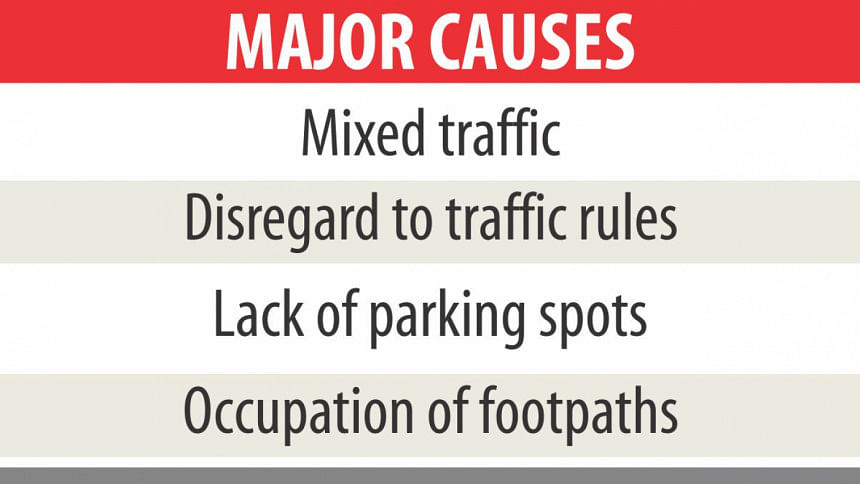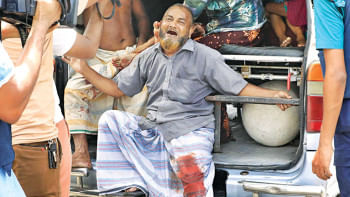Ctg traffic chaos getting worse

Even four to five years back traffic congestion on the streets of Chittagong city, reputed as a relatively clean city, was hardly seen. Now it has become a common phenomenon.
Day after day, commuters in the city with a population of about six million, losing their valuable time on the road and going through immense plight as traffic gridlock is gradually taking severe proportions.
“I have to start at 6:30am from my Mailermatha area residence an hour before my office starts, keeping in mind about the possible traffic jam,” said Arfanur Rahman, an official of Lhotse (BD) Ltd at Karnaphuli EPZ.
“It is a only a 10-minute bus ride from my residence to office,” he said, adding, the condition often turns worse after office as it takes almost two hours to return home due to traffic jam.

Ariful Islam, a private job holder who travels from the city's Kazir Dewry to Panchlaish area regularly, said his 10-minute distance between these two places takes almost 35 to 40 minutes due the to traffic jam.
It is getting intolerable day by day, he added.
Echoing the duo, CNG-run auto-rickshaw driver Imran Hossain said it took him around 15 to 20 minutes to reach AK Khan Road from Muradpur a few years back. Now it takes nearly an hour or more.
According to transport expert Subhash Barua, various reasons including plying of motorised and non-motorised vehicles on the same road, absence of proper traffic management, occupation of footpaths, not following traffic signals and scarcity of parking spots -- are responsible for the city's traffic gridlock.
Through effective traffic management it is possible to increase a road's capacity at least threefold and get rid of traffic congestion, opined Subhash, also the vice-president of Forum for Planned Chittagong.
To bring everything into a system, there requires a planning department which will do all the planning regarding traffic -- fixing stoppages for vehicles and parking spaces, controlling the number of public transports and so on -- to remove the chaotic situation in the transport sector.
Several officials of the traffic division of Chittagong Metropolitan Police (CMP) held a few other factors responsible for the traffic jam.
These are: having no terminals for city buses as well as long-route vehicles; violation of traffic rules by drivers; parking vehicles on roads and intersections randomly; an increase in the number of vehicles; road digging for development works; and construction of flyovers.
Apart from solving these problems awareness should be raised among drivers and transport owners to mitigate traffic congestion, they recommended.
Mostafa Al Mamun, traffic inspector (Akbar Shah area), said due to a lack of terminals and parking lots, drivers park their vehicles haphazardly on the road creating traffic jam frequently.
Proper management is also required to control the number of public transports on specific routes, he noted.
President of Chittagong Regional Committee of Bangladesh Sarok Paribahan Sramik Federation Mohammad Musa said as transport owners set a fixed amount of money to deposit daily, drivers often violate traffic rules by stopping in the middle of the road to drop and take passengers causing hindrance to other vehicles.
According to BRTA officials, about 1,14,230 vehicles got registered from January 1980 to December 2011 in the city but total numbers of registered vehicles stood at 1,52,000 by October 2016.
Actions are being taken against the traffic rule violators regularly, said Masood-ul-Hasan, additional commissioner (traffic) of Chittagong Metropolitan Police (CMP).
On an average they are giving Tk 1 crore to the government every month, realised from the traffic rules violators, he added.
“We are trying our best to mitigate traffic jam,” he said, adding, but cooperation from all concerned is also required in this regard.
A separate system is required for vehicles, to and from Chittagong Port, so that those vehicles do not need to ply on the main road of the city, he said, adding, otherwise the problem would increase further.
They have a plan to fix parking spaces and designated bus stoppages to reduce traffic jam with the cooperation of the CCC, he added.
There are about 200km footpaths in the city, said CCC Chief Engineer Lt Col Mohiuddin Ahamed.
When asked about the length of the footpath that is illegally occupied, he said a survey is going on to find it out.
According to CCC sources, so far about 782 floating shops, constructed occupying footpaths, were demolished after AJM Nasir Uddin took over the mayoral responsibilities of CCC on July 26, 2015.
Nasir said they are conducting demolition drive regularly to free the footpaths.
“Everything is not possible overnight. We need time to solve the problem,” Nasir noted.

 For all latest news, follow The Daily Star's Google News channel.
For all latest news, follow The Daily Star's Google News channel. 



Comments